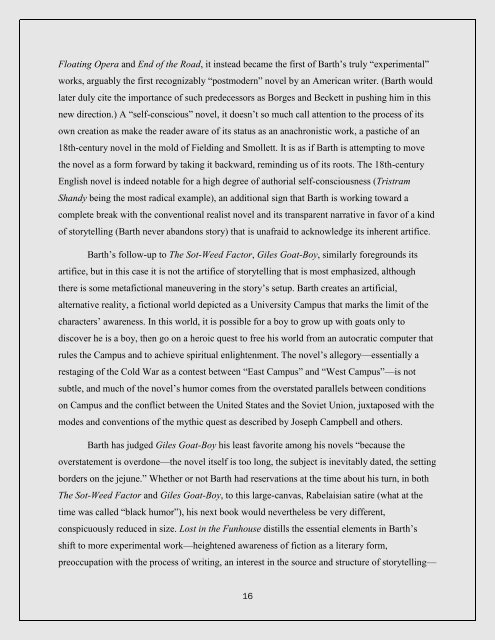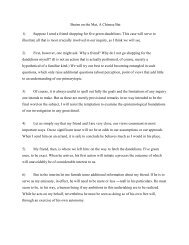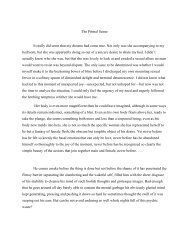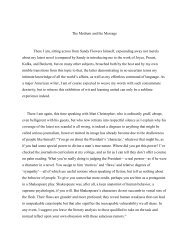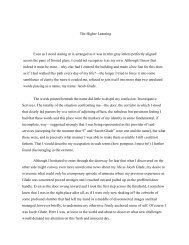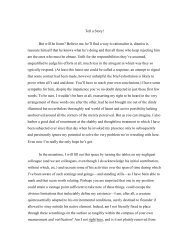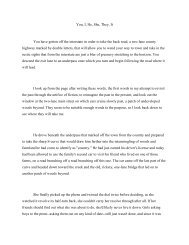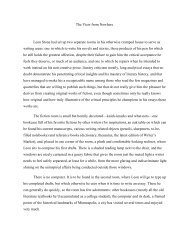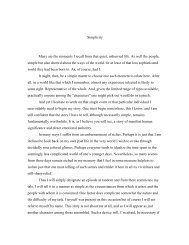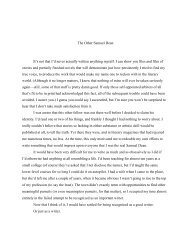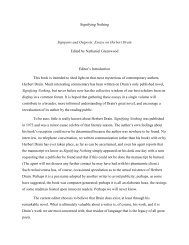APF
Create successful ePaper yourself
Turn your PDF publications into a flip-book with our unique Google optimized e-Paper software.
Floating Opera and End of the Road, it instead became the first of Barth’s truly “experimental”<br />
works, arguably the first recognizably “postmodern” novel by an American writer. (Barth would<br />
later duly cite the importance of such predecessors as Borges and Beckett in pushing him in this<br />
new direction.) A “self-conscious” novel, it doesn’t so much call attention to the process of its<br />
own creation as make the reader aware of its status as an anachronistic work, a pastiche of an<br />
18th-century novel in the mold of Fielding and Smollett. It is as if Barth is attempting to move<br />
the novel as a form forward by taking it backward, reminding us of its roots. The 18th-century<br />
English novel is indeed notable for a high degree of authorial self-consciousness (Tristram<br />
Shandy being the most radical example), an additional sign that Barth is working toward a<br />
complete break with the conventional realist novel and its transparent narrative in favor of a kind<br />
of storytelling (Barth never abandons story) that is unafraid to acknowledge its inherent artifice.<br />
Barth’s follow-up to The Sot-Weed Factor, Giles Goat-Boy, similarly foregrounds its<br />
artifice, but in this case it is not the artifice of storytelling that is most emphasized, although<br />
there is some metafictional maneuvering in the story’s setup. Barth creates an artificial,<br />
alternative reality, a fictional world depicted as a University Campus that marks the limit of the<br />
characters’ awareness. In this world, it is possible for a boy to grow up with goats only to<br />
discover he is a boy, then go on a heroic quest to free his world from an autocratic computer that<br />
rules the Campus and to achieve spiritual enlightenment. The novel’s allegory—essentially a<br />
restaging of the Cold War as a contest between “East Campus” and “West Campus”—is not<br />
subtle, and much of the novel’s humor comes from the overstated parallels between conditions<br />
on Campus and the conflict between the United States and the Soviet Union, juxtaposed with the<br />
modes and conventions of the mythic quest as described by Joseph Campbell and others.<br />
Barth has judged Giles Goat-Boy his least favorite among his novels “because the<br />
overstatement is overdone—the novel itself is too long, the subject is inevitably dated, the setting<br />
borders on the jejune.” Whether or not Barth had reservations at the time about his turn, in both<br />
The Sot-Weed Factor and Giles Goat-Boy, to this large-canvas, Rabelaisian satire (what at the<br />
time was called “black humor”), his next book would nevertheless be very different,<br />
conspicuously reduced in size. Lost in the Funhouse distills the essential elements in Barth’s<br />
shift to more experimental work—heightened awareness of fiction as a literary form,<br />
preoccupation with the process of writing, an interest in the source and structure of storytelling—<br />
16


